† Corresponding author. E-mail:
‡ Corresponding author. E-mail:
Project supported by the National Natural Science Foundation of China (Grant Nos. 11374360, 11405266, and 11505285) and the National Basic Research Program of China (Grant No. 2013CBA01504).
As is known to all, the electron scattering in classical electromagnetic potential is one of the most widespread applications of quantum theory. Nevertheless, many discussions about electron scattering are based upon single-particle Schrodinger equation or Dirac equation in quantum mechanics rather than the method of quantum field theory. In this paper, by using the path integral approach of quantum field theory, we perturbatively evaluate the scattering amplitude up to the second order for the electron scattering by the classical electromagnetic potential. The results we derive are convenient to apply to all sorts of potential forms. Furthermore, by means of the obtained results, we give explicit calculations for the one-dimensional electric potential.
The original concept of the path integral approach may stem from the Wiener integral, which was proposed by Norbert Wiener in order to study the stochastic process of Brownian motion. In 1933, Dirac[1] extended Wiener’s idea to bring in quantum mechanics for establishing the action principle and its Lagrangian formalism.
The thorough and complete path integral approach was developed by Richard Feynman[2] in 1948. In 1963, Feynman expressed the gravitational interaction of two particles by means of an interchange of a virtual graviton.[3] The mathematical technique of the path integral approach was first applied to non-Abelian gauge fields. In 1967, Faddeev and Popov[4] utilized the path integral approach to obtain the detailed quantization rules which are observed to calculate the contribution from arbitrary Feynman diagrams in the theory of SU(2) gauge invariant fields. In 1971, with the help of the path integral approach and dimensional regularization method, Hooft[5] successfully demonstrated that massive Lagrangians for non-Abelian gauge theories without anomalies are renormalizable. At present, the Higgs boson,[6–9] which is the last elementary particle with a mass near 125 GeV predicted by the standard model of particle physics, had been discovered in the ATLAS and CMS experiments at CERN’s Large Hadron Collider on 4 July 2012, and all observational evidence points to the fact that quantum field theory provides an accurate description of all known elementary particles. In retrospect, it is clearly shown that the path integral approach is of great significance for the development of quantum field theory.
On the other hand, since the first ruby laser was invented in 1960 by Maiman at Hughes Laboratories, particularly with the rapid development of chirped pulse amplification, laser power has achieved tremendous growth. Nowadays, it has been reported that the present world highest laser intensity is the HERCULES laser produced by the University of Michigan, whose focused laser intensity has achieved as high as 2 × 1022 W/cm2.[10] Consequently, a large number of theoretical and experimental phenomena which are involved in the processes of the electron scattering in the strong laser field, such as acceleration of electrons,[11,12] Thomson backscattering of optical laser light off relativistic electrons,[13–16] and nonlinear Compton scattering,[17–21] need to be discussed further.
Therefore, seeing that many new operator methods have witnessed a boom in quantum mechanics, such as the operator-Hermite-polynomial method,[22] as far as the application of the method is concerned, we believe that it is crucial to treat the classical problem of the electron scattering with the path integral approach which plays a central role in quantum field theory. The main merit of the path integral approach is that it provides a comparatively convenient road to quantization and to expression for correlation function, which is closely related to amplitudes for electron scattering processes.
This paper is organized as follows. In Section 2, we introduce the Grassmann algebra, generating functional and correlation functions in the path integral approach of quantum field theory. In Section 3, we apply the perturbation technique to calculate the correlation function up to the second order. Based on Lehmann–Symanzik–Zimmermann (LSZ) reduction formula, we derive a general result for the electron scattering off the classical electromagnetic potential. In Section 4, we shall present an explicit calculation that is the electron scattering off the one-dimensional time-independent electric potential to illustrate the use of the results presented in Section 3. In Section 5, we shall discuss a heuristic application of the Gaussian barrier. Finally, in Section 6, we shall give a brief summary.
The foundational component of path integral formalism is the generating functional of correlation functions.[23] For the spinor field, it reads



To begin, we need to refer to the definition of the functional derivatives, δ/δη and 




To evaluate the path integral 






On the basis of path integral formulism, the two-point correlation function for the spinor field is given by

Consider Eq. (
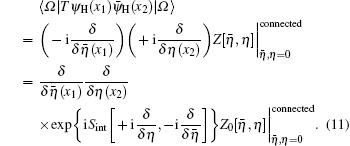
To compute 


The zero-order term in the expansion of Eq. (

For the first-order term, it reads
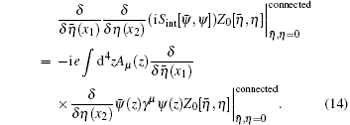

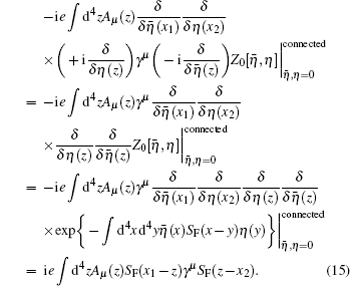
For the second-order term, it becomes complicated. We need to calculate the following quantity:


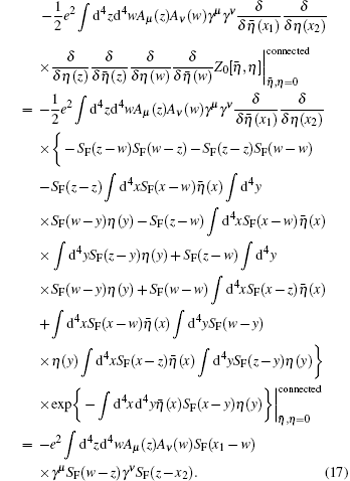
By applying the generalized LSZ reduction formula[24] for the spinor field, we establish the connection between the two-point correlation function and the

To isolate the interaction part of the

The lowest non-trivial order contribution for
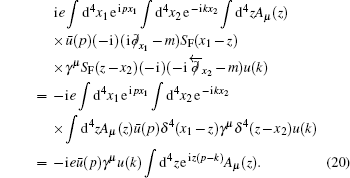


Continuing to consider the situation of the second-order term, we obtain
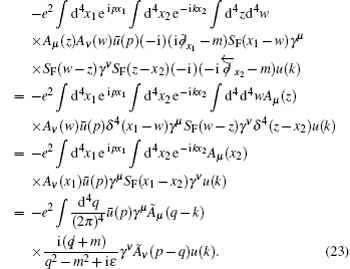
Substituting the result of Eq. (


Therefore, summing up the above, we finally have

In this section, we have now shown that we utilize the result obtained in Eq. (




To describe the electron scattering process completely, we have to integrate over the final momentum p3 with the Lorentz-invariant measure,
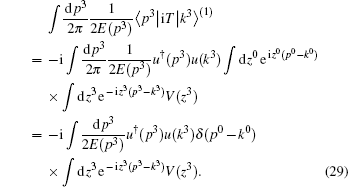
In order to make our subsequent calculations easily, it is convenient to write the normalization condition for spinor u(p) as


With the aim of performing the integration over p3, we use the identity equation[25] as

Namely, for the reflection part of electron scattering, p3 = −k3, at the level of first order, we have
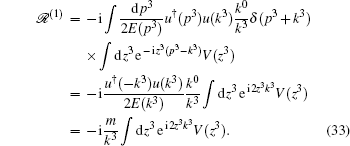
Analogously, for the transmission part, p3 = k3, we have

At the level of second order, the T-matrix element has
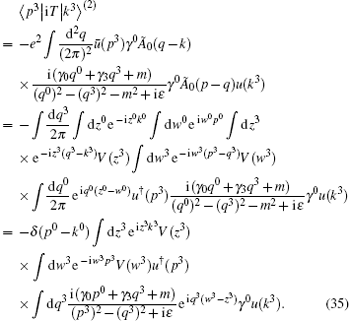



For transmission, p3 = k3. At the level of second order, we obtain that

As a kind of concrete application, we choose V(z3) as the Gaussian barrier given that it has a bearing on the strong laser field in optics, which is a radially symmetrical distribution whose potential variation is given by

For convenience, much emphasis is placed on the transmission part. Our calculations presented in Section 4 show that equations (

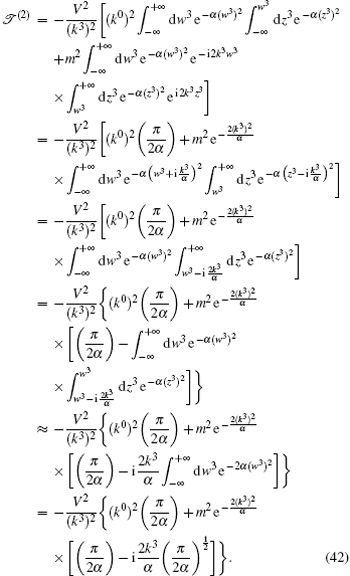

Then, the total transmission amplitude including the trivial part of the zero order is given as follows:

In the previous five sections, by using path integral approach, we have calculated the first- and second-order contributions of quantum field theory to the process of the electron scattering. Indeed, according to the general principle of quantum field theory, we need to quantize the spinor field and electromagnetic field simultaneously. However, to compare our final results directly with those of the single-particle Schrodinger equation or Dirac equation, we no longer quantize the electromagnetic field. Instead, we treat the field as a given, classical four-dimensional potential Aμ (x) throughout.
Usually, it is sufficient to solve most scattering problems using single-particle theory. Yet, sometimes one needs to consider more complicated situations which should use field theory like scattering problems in the strong laser fields. Therefore, the purpose of this paper is to show that the expression we derive in Eq. (
| 1 | |
| 2 | |
| 3 | |
| 4 | |
| 5 | |
| 6 | |
| 7 | |
| 8 | |
| 9 | |
| 10 | |
| 11 | |
| 12 | |
| 13 | |
| 14 | |
| 15 | |
| 16 | |
| 17 | |
| 18 | |
| 19 | |
| 20 | |
| 21 | |
| 22 | |
| 23 | |
| 24 | |
| 25 | |
| 26 | |
| 27 | |
| 28 | |
| 29 | |
| 30 | |
| 31 | |
| 32 |


